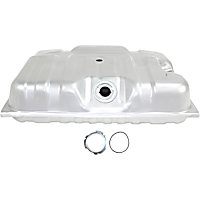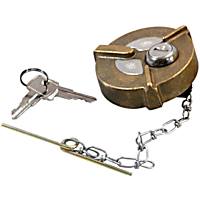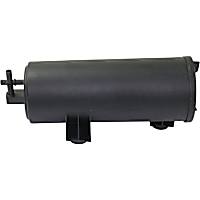If the Check Engine Light is illuminated on your dashboard and your OBD-II scanner shows a P0441 trouble code, this means that there’s a problem with your EVAP system—or more specifically, the purge valve has incorrect purge overflow.
To find out more about what a P0441 code entails and what may have caused it, read our guide below.

What Does the P0441 Code Mean?
Diagnostic trouble code (DTC) P0441 stands for “Evaporative Emission Control System (EVAP) Incorrect Purge Flow.” Your car’s computer will set the code when it determines there’s an improper amount of fuel vapor being “purged” from the EVAP charcoal canister into the engine.
This code only appears on vehicles that have a purge flow sensor or a leak detection pump. Early OBD2 Ford Rangers with non-enhanced EVAP systems simply had a small thermistor in the purge flow line that reported purge flow. Toyotas and Dodge vehicles with Leak Detection Pumps (LDP) measure system pressure changes to determine purge flow valve operation. For that reason, these systems won’t run the purge flow test until the leak tests are completed and passed. Many vehicles don’t list this trouble code.

For a detailed technical discussion of how the purge valve and other EVAP system components work, read the next section.
If you want to know the possible causes of P0441, click here.
What is an EVAP system and what is a purge valve?
The EVAP system is a collection of components working together to prevent fuel vapors from entering the atmosphere. The main components in an EVAP system include the gas tank, the gas cap, the vent valve, the purge valve, and the charcoal canister. Keep in mind, however, that system designs vary significantly between makes and even within the same vehicle make between models. The common components are the canister and some type of canister purge valve that delivers a weak vacuum to the canister where the vapors are stored. There is also some type of mechanical or electronic pressure sensor used on EVAP systems.
When the engine is off, fuel vapors are stored in the charcoal canister, rather than escaping into the atmosphere. Once the engine is running and the appropriate conditions are met, the purge valve opens to allow the vapors to enter the engine, where they are burned during the normal combustion process.
Early (pre-OBD2) systems only purged the canister when the engine was above idle and warm. OBD2 systems may purge the canister any time the engine is running, even at idle. That’s why it’s important not to “pack” the fuel tank, but let the nozzle stop when it clicks off. If you pack the tank, you can saturate the canister with fuel; the purge system doesn’t know this and if it begins to purge at idle, the engine may almost stall and then over-correct with the idle speed control, causing the vehicle to surge ahead unexpectedly at traffic lights and drive-thrus. Again, don’t pack the gas tank!
Early (pre-OBD2) systems only purged the canister when the engine was above idle and warm. OBD2 systems may purge the canister any time the engine is running, even at idle. That’s why it’s important not to “pack” the fuel tank, but let the nozzle stop when it clicks off.
–Richard McCuistian, ASE Certified Master Automobile Technician
The vent valve is a normally open valve connected to the port on the canister where fresh air enters to purge the vapors during EVAP purge events when a weak vacuum from the engine is delivered to the opposite port. The purged vapor is carried into the intake manifold and passes through the combustion chamber.
Again, this canister vent valve is usually open unless the system is running one of its self-tests. Vehicles with Leak Detection Pumps operate in a slightly different way, but that’s another story.
Your car’s computer controls and monitors the purge and vent valves. When the device is performing the EVAP system self-tests, it will typically close off the system, then open the purge valve under the right conditions.
To calculate purge flow, the computer uses a fuel tank pressure sensor to measure the rate at which vacuum (negative pressure) increases in the EVAP system.

What are the Possible Causes of the P0441 Code?
While a number of things may cause the code P0441 to show up, listed below are its most likely causes.
- A bad purge valve
- A clogged or disconnected purge line
- Insufficient purge valve vacuum supply
- Circuit issues (e.g., damaged wiring, loose connections)
- Control module (computer) problems, such as software in need of an update
- Other EVAP system issues that could interrupt purge flow
What are the Common Symptoms of the P0441 Code?
Typically, the only common symptom that you may experience if your car is triggering the error code P0441 is an illuminated Check Engine Light.
Another symptom that some have reported observing is a distinct smell of fuel when in or around the car, although this is not as common.
How to Diagnose the P0441 Code
It can be difficult to diagnose and pinpoint the exact cause of most OBD-II codes due to the fact that they often have numerous possible causes. This is the same for a code P0441.
For an idea of how to troubleshoot the code, check out the videos below:
How to Fix the P0441 Code
Unfortunately, there is no “magic bullet” fix for a code P0441. This is due to the fact that there is a variety of possible causes, and there are different ways to fix the issue depending on the exact cause.
You’ll need to diagnose the code accurately and pinpoint the cause, as outlined in the videos above, then perform any necessary repairs.
And remember—all vehicles are different. When troubleshooting and repairing diagnostic trouble codes, make sure to consult the factory repair information for your application.
Repair manuals, such as those from Chilton, are useful, but an ALLDATA subscription is even better. ALLDATA has single-vehicle subscriptions for DIYers that provide detailed factory repair information.
Other Notes About Code P0441
Unlike other OBD-II trouble codes, a P0441 does not pose a serious risk that can potentially jeopardize your safety on the road—which means that you can technically drive the vehicle without any issues. Your EVAP system, or more specifically, the purge valve, is not a necessary part of driving your car safely.
However, like most parts, failure to address it may result in more components being damaged. The best thing to do is to have your car checked by a licensed professional as soon as you can.
Where to Get a New Purge Valve for Your Vehicle
If a faulty purge valve triggered the P0441 code, don’t delay replacing it. It could cause issues that are expensive to resolve, such as engine trouble and a collapsed fuel tank. Luckily, CarParts.com has high-quality replacement valves on hand and ready to ship.
Our wide selection of OE-quality purge valves comes from top manufacturers, so rest assured that you’ll get one that works like your stock part. Use our vehicle selector and filters to find what you need in minutes. Once you’ve placed your order, we’ll have it delivered to you in as fast as two business days.
If you need help or have questions, our friendly customer service team is ready 24/7 to assist you. We also have a 60-day return policy in the unlikely event you aren’t satisfied with your order. For immediate product returns, simply file a claim through our returns center, and we’ll issue you a full refund.
So don’t wait for your purge valve to be sluggish and unusable. Shop for a replacement at CarParts.com today.
Products Mentioned in this Guide
Any information provided on this Website is for informational purposes only and is not intended to replace consultation with a professional mechanic. The accuracy and timeliness of the information may change from the time of publication.


 Fuel Tank
Fuel Tank
 Gas Cap
Gas Cap
 Fuel Tank Vent Valve
Fuel Tank Vent Valve
 Vapor Canister
Vapor Canister
 Purge Valve
Purge Valve
















Thanks for the useful info!
Hi Mike,
Thanks for the positive feedback! We’re glad you found this article to be helpful.
I getting this code after driving a couple of hundred miles with a loose gas cap. Will I need replace the cannister on my 2015 Toyota Camry?
Hello,
Even though this code can be caused by a variety of issues, the most common cause of the code on your Toyota is a faulty purge valve. However, we recommend getting a professional, in-person diagnosis for a definitive answer.
I have a p0441 code on my 2014 Mercedes’ c250, took it to a place and they said I need 2 new fuel pumps and it’ll cost me $1600. I thought when fuel pumps are broken, your car doesn’t run. But my car runs just fine?
Hello,
We aren’t sure why both pumps would be needed to cure that code, either. We recommend asking the shop to explain their diagnosis.
Hello, my car has this code and has check engine light on. It also has a clicking noise under the car. What does this mean?
I have the same problem.
Hi I have the codes comes together they are u0401-68 , p0441